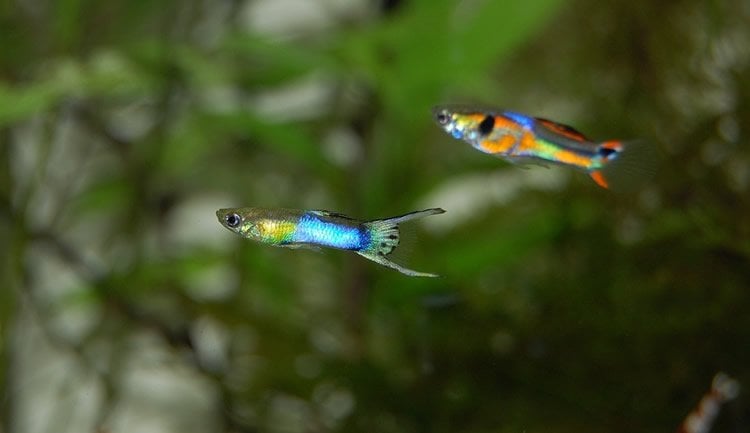Summary: Researchers report male guppies who live in an environment with predators have greater brain mass than those who live in a predator free environment. However, there is no difference in brain size for female guppies.
Source: British Ecological Society.
Male guppies exposed to predators in the wild or in captivity have heavier brains than those living in relatively predator-free conditions, according to new research published in the journal Functional Ecology.
Behavioural ecologists from Liverpool John Moores University, UK and McGill University, Canada sampled guppies from two rivers in northern Trinidad. In each river, guppies live above a waterfall, a location that only guppies and a few other small species of fish have managed to colonize, and below the fall, where many predators including pike cichlids live.
“Guppies offer an excellent model for evolutionary research because they have colonized multiple independent rivers in Trinidad where they are exposed to a variety of different conditions”, said Dr Adam Reddon, now at Liverpool John Moores University’s School of Natural Sciences and Psychology. “We were particularly interested in finding out how the brains of these widely-distributed fish have evolved for dealing with the challenges of living under predation threat.”
The researchers looked at whether there are differences in relative brain mass between wild guppies collected from high and low predation populations and found that, for their body size, males collected from high predation sites had on average 17% heavier brains compared to males from low predation sites in the same river. Female guppies, by contrast, did not show this pattern.
To test the origins of these findings, the ecologists conducted a laboratory experiment in which they exposed young guppies to cues of predation risk.
“The brain is a highly malleable organ and experiences early in life can shape how it develops. We wanted to see if the predation effect we detected in male guppies in the wild could be due to experiences in their early life stages”, commented Laura Chouinard-Thuly of McGill University, also an author on this paper.
The fish were exposed to the sight of a predator living in an adjacent aquarium for five minutes at a time, five times a week during the first 45 days of their life. The researchers also added the scents of predators and an alarm cue released by guppies. Guppies in the control group were exposed to the sight and smells of a non-predatory fish.
Again, the researchers found that males exposed to predator cues during development had 21% heavier brains than the control group. They found no evidence that the exposure to predation cues influenced the relative brain mass of female guppies.

Males are more brightly coloured and attractive to predators. The results suggest that a larger brain for their body size is advantageous under predation threat, perhaps allowing the fish to detect, learn about or react to predators better.
Reddon commented: “It is also possible that guppies with bigger brains are better at doing two things at once. For instance, males spend a lot of time courting females and it may be that those with a bigger brain can do this while keeping an eye out for predators.”
Brains can use a lot of energy and are generally only as big as they need to be for animal survival and reproduction. Female guppies are 2-10 times the size of males and tend to live longer. They play a slow and steady strategy to reproduction and so may consistently benefit from paying the high costs of building and maintaining larger brain tissue, whereas male guppies may only benefit under high predation risk.
Source: Sabrina Weiss – British Ecological Society
Publisher: Organized by NeuroscienceNews.com.
Image Source: NeuroscienceNews.com image is in the public domain.
Original Research: Open access research for “Wild and laboratory exposure to cues of predation risk increases relative brain mass in male guppies” by Adam R. Reddon, Laura Chouinard‐Thuly, Ioannis Leris, and Simon M. Reader in Functional Ecology. Published June 4 2018.
doi:10.1111/1365-2435.13128
[cbtabs][cbtab title=”MLA”]British Ecological Society “Male Guppies Grow Larger Brains in Response to Predator Exposure.” NeuroscienceNews. NeuroscienceNews, 5 June 2018.
<https://neurosciencenews.com/guppie-predator-brain-9256/>.[/cbtab][cbtab title=”APA”]British Ecological Society (2018, June 5). Male Guppies Grow Larger Brains in Response to Predator Exposure. NeuroscienceNews. Retrieved June 5, 2018 from https://neurosciencenews.com/guppie-predator-brain-9256/[/cbtab][cbtab title=”Chicago”]British Ecological Society “Male Guppies Grow Larger Brains in Response to Predator Exposure.” https://neurosciencenews.com/guppie-predator-brain-9256/ (accessed June 5, 2018).[/cbtab][/cbtabs]
Abstract
Wild and laboratory exposure to cues of predation risk increases relative brain mass in male guppies
There is considerable diversity in brain size within and among species, and substantial dispute over the causes, consequences and importance of this variation. Comparative and developmental studies are essential in addressing this controversy.
Predation pressure has been proposed as a major force shaping brain, behaviour and life history. The Trinidadian guppy, Poecilia reticulata, shows dramatic variation in predation pressure across populations. We compared the brain mass of guppies from high and low predation populations collected in the wild. Male but not female guppies exposed to high predation possessed heavier brains for their body size compared to fish from low predation populations.
The brain is a plastic organ, so it is possible that the population differences we observed were partly due to developmental responses rather than evolved differences. In a follow‐up study, we raised guppies under cues of predation risk or in a control condition. Male guppies exposed to predator cues early in life had heavier brains relative to their body size than control males, while females showed no significant effect of treatment.
Collectively our results suggest that male guppies exposed to predation invest more in neural tissue, and that these differences are at least partly driven by plastic responses.







